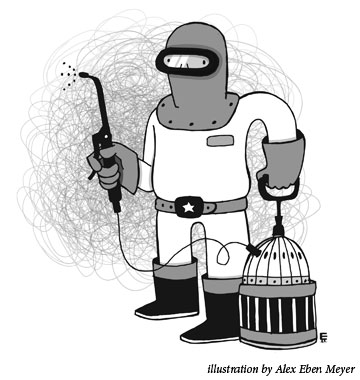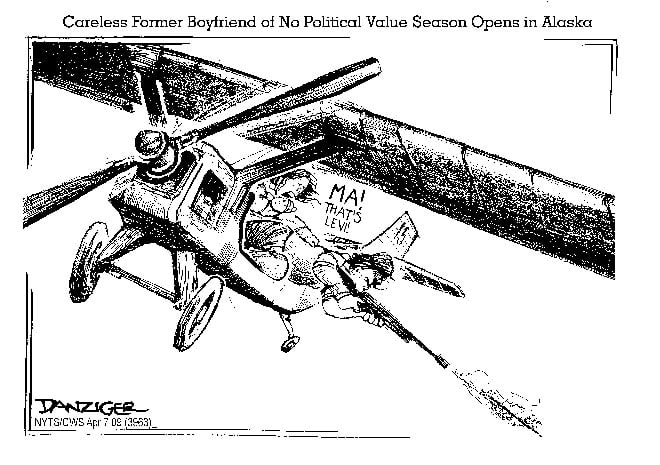Political Intelligence
Bugging Out on Pesticides
In a state known for flying roaches the size of small planes and a fire ant population that outnumbers humans, it’s not surprising that many people use pesticides. Of course, the pesticides are often more dangerous than the pests, especially to children. Now some of Texas’ anti-pesticide advocates-there aren’t many-are concerned that the Texas Department of Agriculture is considering loosening restrictions on pesticide use in schools.
Mary Hintikka never really thought about pesticides sprayed on school grounds, including outdoor gardens and athletic fields, even inside buildings. But as she watched her school-age son develop frequent, unexplained illnesses, she began to suspect that pesticides might be the cause. She was alarmed to learn that the powerful chemicals sprayed in and around her son’s Houston school included chemicals on the Environmental Protection Agency’s list of the most dangerous pesticides. Children with long-term or acute exposure to some of these chemicals, numerous studies have shown, are more likely to suffer from childhood leukemia, soft-tissue sarcoma, and brain cancer.
In 2007, the Legislature passed a bill by Corsicana Republican state Rep. Byron Cook that abolished the Structural Pest Control Board-by most accounts, a lax regulatory body-and folded its duties into the Agriculture Department. The idea behind the bill was to strengthen oversight and regulation of pesticides, especially for schools. The bill instructed the department to create new regulations for pesticide use at schools.
The agency released a draft of the new rules last summer, and they were much stricter. Schools could only spray the most powerful pesticides-those in the so-called red category (there are also green and yellow designations)-if students wouldn’t be within 100 feet of the spray area for at least 12 hours. The proposed 100-foot buffer was double the current standard, 50 feet for 12 hours.

(That’s still not ideal. Beyond Pesticides, a nonprofit advocacy group based in Washington, D.C., has recommended that students not be allowed in sprayed areas for at least 24 hours.)
The pesticide industry and school boards didn’t like the proposal. They complained to the agency, saying the buffer zone was too onerous, says Bryan Black, a department spokesman. So in its most recent revision, released earlier this year, the department recommends that schools spray only where students won’t be within 25 feet for eight hours. That’s not only lower than the agency’s draft, it’s lower than the current standard.
Black says the department consulted experts at Texas A&M’s Southwest Technical Resource Center in formulating the new standard. “We believe these standards are absolutely safe,” he says. “We’re not going to do anything that would put children in danger.”
But Hintikka-like Sue Pitman, a pesticide expert who once worked in Texas and now lives in Colorado-worries that the department is bowing to pressure from industry and schools. Hintikka says the reason for moving pesticide oversight to the Agriculture Department was to strengthen standards, not weaken them.
The department hasn’t finalized the rules. The agency will decide in the next month to either implement the proposal or revise it again. In the meantime, Hintikka says, parents should find out exactly what pesticides are being used at their kids’ schools.
Conservation Catching On?
Not if T. Boone Pickens has his way
In most respects, Hemphill County is like the rest of the Texas Panhandle: rural, conservative, windy as hell. But when it comes to planning for the dwindling Ogallala Aquifer, the sole water source for much of northwest Texas, the county is doing things differently.
Most Panhandle communities plan to draw down their portion of the aquifer by half or more over the next 50 years, decisions driven largely by irrigated agriculture and water ranchers. Not Hemphill County. With little agriculture and abundant surface water, the sparsely populated county is fighting to leave as much water in the ground as possible.
Canadian, the county seat and only major town, is known as the “Oasis of the Panhandle” for its numerous rivers, creeks, springs, and seeps that provide habitat for birds and wildlife. “Even the conservative people have latched onto ecotourism as an economic engine for the area,” says Laura Marbury, a water specialist with the Environmental Defense Fund. As part of the 50-year state water planning process, the Hemphill County Underground Water Conservation District has proposed leaving 80 percent of the aquifer underlying the county intact by 2060.
That makes T. Boone Pickens mad.
Through his company Mesa Water Inc., Pickens has amassed some 200,000 acre-feet of Panhandle groundwater and wants to export it eventually to Dallas, Fort Worth, or San Antonio. Pickens’ business plan works best under Texas’ infamous Rule of Capture, sometimes wryly referred to as May the Biggest Pump Win. Over the years, as the threat of aquifer depletion has grown, groundwater districts have imposed stricter regulations on pumping. Hemphill is particularly strict.
In January, Mesa attorney Robert Stillwell dashed off an angry letter to the Texas Water Development Board and the chairmen of the House and Senate Natural Resources committees calling the pumping limits “extreme” and the Hemphill water district a “poster child of abuse.” In the letter, Mesa claims its 15,000 acre-feet of water rights in the county have been “rendered basically worthless” and threatens to sue the district. In an e-mail to the Observer, Stillwell accused the district of being against all exports of water from Hemphill County.
Not so, says Julie Guthrie, general manager of the water district. “Our goal hasn’t been to stop the use of water in Hemphill County or to stop exports,” she says. “You can’t do it. That’s a lawsuit you will lose. But you can call for orderly development and the conservation of water.”
If Mesa had its way, depletion set at 50 percent or more, springs would cease flowing in the area, and many water wells would go dry, according to modeling by the water district. In many respects, Hemphill is setting an example for water management: a model based on sound science, recognition of linkages between surface water and groundwater, and something like sustainability. Maybe that’s what has Pickens worried, suggests Guthrie.
“One would assume that a concern [for Pickens] is that conservation is going to actually catch on.”
Apparently sharing that concern, Rep. Frank Corte, a San Antonio Republican, has filed House Bill 3494, which would give the Texas Water Development Board final say on water districts’ pumping limits. The measure is opposed by the Texas Alliance of Groundwater Districts for undermining the state’s tradition of “local control.”
Give Them Shelter
Mexican journalists seek asylum
As violence in Juarez escalated last year, at least eight journalists in the troubled Mexican city received death threats via text message. On Nov. 13, it became frighteningly clear that the threats were anything but idle: Armando Rodriguez, a crime reporter for El Diario de Juarez, was gunned down while taking his 8-year-old daughter to school.
Rocio Gallegos, editor of El Diario, says Rodriguez’s murder has profoundly affected the way her reporters go about their work. But it hasn’t shut them down. “We’ve taken new security measures. We change our work schedules often, and we really have to decide whether we will go to a place in person or try to do the story by phone,” she says. Often reporters work in groups, on the safety-in-numbers theory. Gallegos insists they are not paralyzed by fear. “We couldn’t do our jobs if we were afraid,” she says.
Fear is unquestionably crippling the ability of many Mexican journalists to tell the full story of the country’s ongoing tragedies. Reporters from other newspapers and TV stations have fled north, including Jorge Luis Aguirre, director of the online news journal La Polaka. Last November Aguirre sought refuge in El Paso after he was warned that that he would be the next to die. In March, Aguirre testified at a U.S. congressional hearing that the threats stemmed from his criticism of a state prosecutor-and were delivered by a representative of the state of Chihuahua’s governor.
“He sent people to warn me to tone down my criticisms of the prosecutor,” Aguirre testified, “because if I didn’t, he was going to kill me, using the Juarez drug cartels’ preferred method of kidnapping followed by execution.”
Emilio Gutierrez Soto, a reporter for El Diario del Noroeste in the city of Ascension, 145 miles south of Juarez, fled last June with his 15-year-old son after soldiers ransacked his home. He subsequently received death threats. Gutierrez had written a series of stories exposing the harassment of innocent citizens by the army’s anti-drug trafficking operations. Gutierrez landed in a U.S. immigration detention center for seven months before being freed in January without explanation on a temporary visa. His son was held in detention for two months before being released to U.S. relatives. They are applying for asylum.
In February, Gutierrez and Aguirre helped form a group in El Paso to assist journalists fleeing the violence. Periodistas Mexicanos en Exilio (Mexican Journalists in Exile), or PEMEXX, will provide legal assistance and counseling to Mexican journalists who seek asylum in the U.S. At a press conference at UT-El Paso, immigration lawyer Carlos Spector, another co-founder of PEMEXX, said it also aims to “put pressure on the Mexican government to provide assistance to those who are fleeing Mexico.”
“If the press is silenced or diminished in Mexico,” Spector said, “the hope of democracy for our neighbors is dwindling just as fast.”
With the help of Gustavo de la Rosa Hickerson, ombudsman for the Chihuahua State Human Rights Commission, PEMEXX is creating a human rights project in Chihuahua to educate journalists about asylum. The group is pressing the Obama administration to respect international agreements relating to asylum and refugee status, which were seldom upheld by the Bush administration.
For Aguirre, the issue is personally urgent: He is living in El Paso, where he’s continued to update his Web site, with his wife and three children on temporary visitor visas that expire in June. He has yet to apply for asylum because he fears he might land in detention, as Gutierrez did.
“Every day I pray with my wife because God has kept me alive,” Aguirre told the congressional committee. “Sometimes, I look at the mountains of Juarez and, like many people, dream of a city that is no longer a paradise for drug cartels, but a safe and dignified place where I can live with my family.”
Beware the Eyes of Texas
elections unearth a secret UT society
Perhaps not since Hank the Hallucination beat Paul Begala for student body president in 1982 has so much controversy swirled around a University of Texas student government election. This year’s contest featured insider dealing, Facebook hijinks, death threats, and a Skull and Bones-like secret society.
The seeds of scandal were sown two days after the election when the Daily Texan anonymously received a copy of an e-mail that called into question the integrity of student elections. Sent by Election Supervisory Board Co-Chairman Cesar Martinez Espinosa three days before the election, the message urged 21 student leaders and alumni to campaign for establishment presidential candidate Liam O’Rourke, the eventual winner.
The 11-member election board is appointed by the student government president and is supposed to oversee elections impartially. But here was Martinez asking recipients to make phone calls, send e-mails, dance at an upcoming Longhorn football game wearing O’Rourke T-shirts, and “facebook like crazy.” In a sad stab at Obama-esque exhortation, Martinez wrote, “This is the time for action, this is our call.”
One recipient was outgoing student body President Keshav Rajagopalan, who appointed Martinez to the election board. Rajagopalan later claimed he hadn’t opened the e-mail. He also claimed it hadn’t been disclosed to protect members of the Eyes of Texas, a secret organization of which he and Martinez are members.
Few on campus had heard of the Eyes, founded in 1978. In his e-mail, Martinez asked his posse for help as a “favor for Eyes.” Critics detected proof of long-held suspicions that student leaders are chosen in advance. “I think [the Eyes] do stupid things like clean off the kiosks,” says Daily Texan editor Leah Finnegan. “But it’s also this established network where they can cherry-pick the next SG presidents.”
The plot thickened when the Texan followed up with another bombshell: Rajagopalan himself had solicited support for O’Rourke and other candidates from five fraternity presidents the day before the election. His e-mail warned of “outsiders” winning.
As that story went to press, the Texan started receiving threatening calls. Finnegan jotted down on a Kleenex what one caller said: “Someone’s going to kill your story. They’re in the building.” Five minutes later, someone called and played “The Eyes of Texas” over the phone. A campus police officer watched the Texan offices that night.
Despite calls for Rajagopalan’s resignation, a do-over election, and even the abolition of student government, little has been done to address the tainted election. Rajagopalan appointed a task force, which he will oversee, to review the process. “There wasn’t really a ton of fallout besides public outcry,” Finnegan says. “No one got punished. No one suffered any consequences.”
In the end, the satirical Texas Travesty, UT’s equivalent of The Onion, may have best captured the mood on campus in a post-election headline: “Dozens shocked by improprieties perpetrated by quasi-important ‘Student Government’.”




